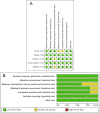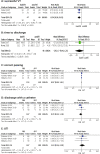Methods of postoperative void trial management after urogynecologic surgery: a systematic review and meta-analysis
- PMID: 37420310
- PMCID: PMC10327332
- DOI: 10.1186/s13643-023-02233-1
Methods of postoperative void trial management after urogynecologic surgery: a systematic review and meta-analysis
Abstract
Background: Voiding trials are used to identify women at risk for postoperative urinary retention while performing optimal voiding trial management with minimal burden to the patient and medical service team. We performed a systematic review and meta-analysis of postoperative void trials following urogynecologic surgery to investigate (1) the optimal postoperative void trial methodology and (2) the optimal criteria for assessing void trial.
Method: We searched PubMed, EMBASE, Cochrane Central Register of Controlled Trials, and relevant reference lists of eligible articles from inception to April 2022. We identified any randomized controlled trials (RCTs) in English that studied void trials in patients undergoing urogynecologic surgery. Study selection (title/abstract and full text), data extraction, and risk of bias assessment were conducted by two independent reviewers. Extracted study outcomes included the following: the correct passing rate, time to discharge, discharge rate without a catheter after the initial void trial, postoperative urinary tract infection, and patient satisfaction.
Results: Void trial methodology included backfill-assisted and autofill studies (2 RCTs, n = 95). Backfill assistance was more likely to be successful than autofill (RR 2.12, 95% CI 1.29, 3.47, P = 0.00); however, no significant difference was found in the time to discharge (WMDs = - 29.11 min, 95% CI - 57.45, 1.23, P = 0.06). The criteria for passing void trial included subjective assessment of the urinary force of stream and objective assessment of the standard voiding trial (3 RCTs, n = 377). No significant differences were found in the correct passing rate (RR 0.97, 95% CI 0.93, 1.01, P = 0.14) or void trial failure rate (RR 0.78, 95% CI 0.52, 1.18, P = 0.24). Moreover, no significant differences were found in the complication rates or patient satisfaction between the two criteria.
Conclusion: Bladder backfilling was associated with a lower rate of catheter discharge after urogynecologic surgery. The subjective assessment of FOS is a reliable and safe method for assessing postoperative voiding because it is less invasive.
Systematic review registration: PROSPERO CRD42022313397.
Keywords: Force of stream (FOS); Standard voiding trial (SVT); Systematic review; Urogynecologic surgery; Void trial (VT).
© 2023. The Author(s).
Conflict of interest statement
The authors declare that they have no competing interests.
Figures
Similar articles
-
Postoperative Urinary Retention Rates after Autofill versus Backfill Void Trial following Total Laparoscopic Hysterectomy: A Randomized Controlled Trial.J Minim Invasive Gynecol. 2021 Apr;28(4):829-837. doi: 10.1016/j.jmig.2020.07.013. Epub 2020 Jul 24. J Minim Invasive Gynecol. 2021. PMID: 32712322 Clinical Trial.
-
Active Compared With Passive Voiding Trials After Midurethral Sling Surgery: A Systematic Review.Obstet Gynecol. 2024 May 1;143(5):633-643. doi: 10.1097/AOG.0000000000005567. Epub 2024 Mar 28. Obstet Gynecol. 2024. PMID: 38547487
-
Comparing Force of Stream With a Standard Fill Voiding Trial After Surgical Repair of Apical Prolapse: A Randomized Controlled Trial.Obstet Gynecol. 2019 Apr;133(4):675-682. doi: 10.1097/AOG.0000000000003159. Obstet Gynecol. 2019. PMID: 30870290 Clinical Trial.
-
Assessment of voiding after sling: a randomized trial of 2 methods of postoperative catheter management after midurethral sling surgery for stress urinary incontinence in women.Am J Obstet Gynecol. 2015 May;212(5):597.e1-9. doi: 10.1016/j.ajog.2014.11.033. Epub 2014 Nov 27. Am J Obstet Gynecol. 2015. PMID: 25434837 Clinical Trial.
-
Retrograde Bladder Filling After Outpatient Gynecologic Surgery: A Systematic Review and Meta-analysis.Obstet Gynecol. 2021 Oct 1;138(4):647-654. doi: 10.1097/AOG.0000000000004541. Obstet Gynecol. 2021. PMID: 34623077
References
-
- Schachar JS, Ossin D, Plair AR, Hurtado EA, Parker-Autry C, Badlani G, Davila GW, Matthews CA. Optimal timing of a second postoperative voiding trial in women with incomplete bladder emptying after vaginal reconstructive surgery: a randomized trial. Am J Obstet Gynecol. 2020;223(2):260.e261–260.e269. doi: 10.1016/j.ajog.2020.06.001. - DOI - PubMed
Publication types
MeSH terms
LinkOut - more resources
Full Text Sources
Medical
Miscellaneous



